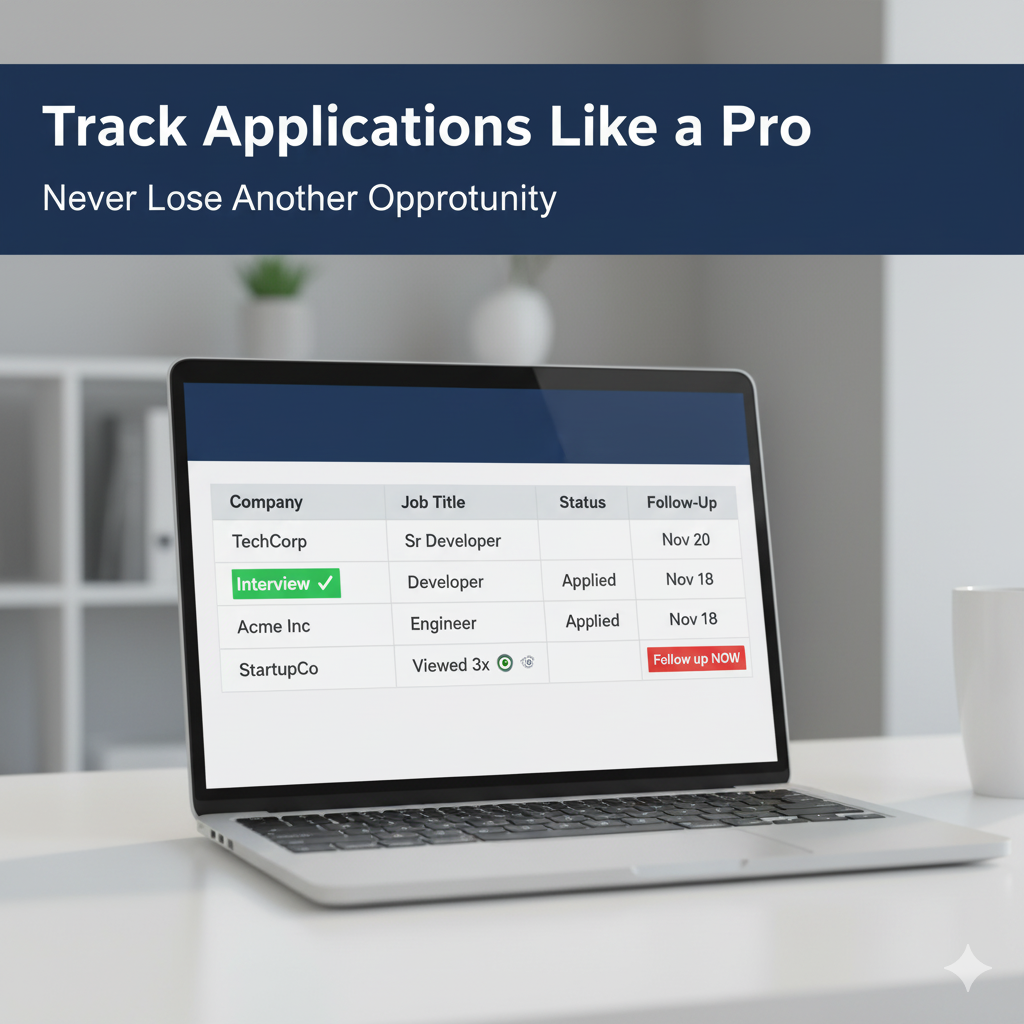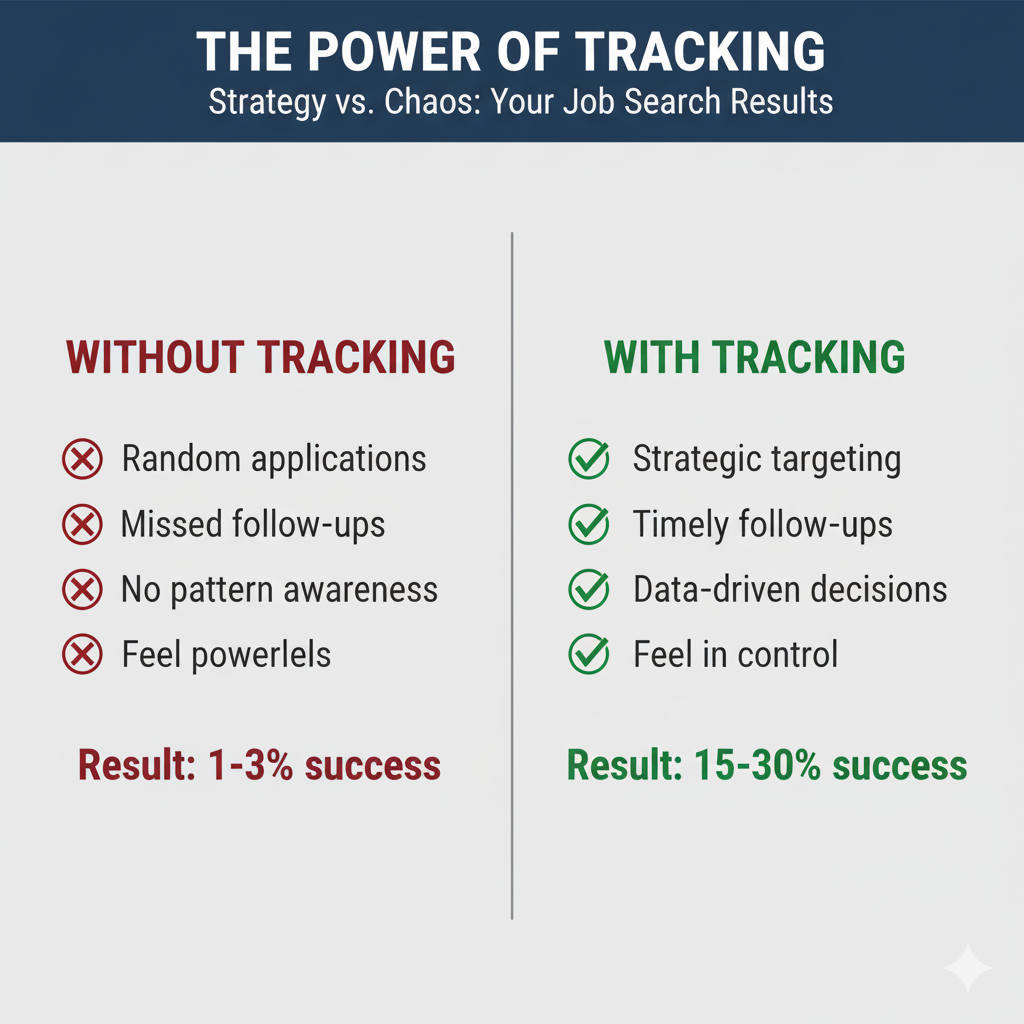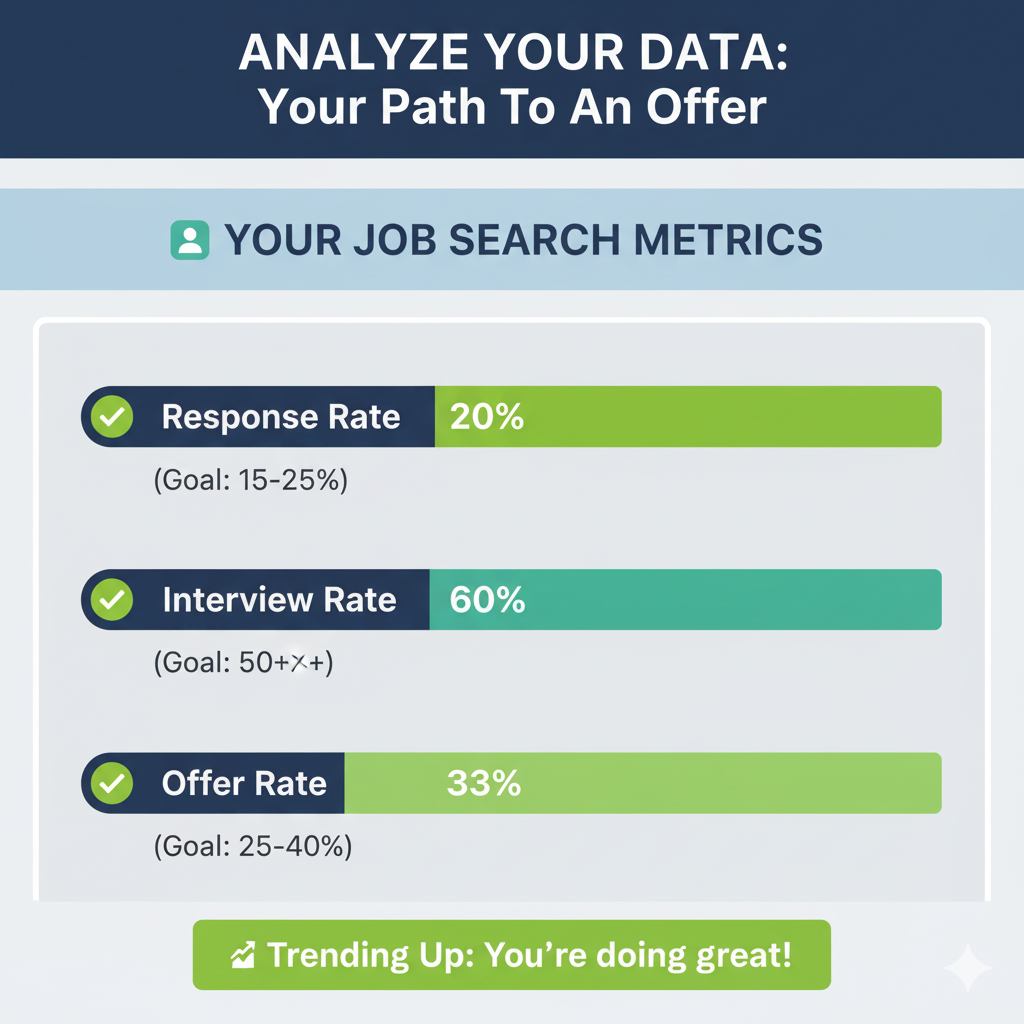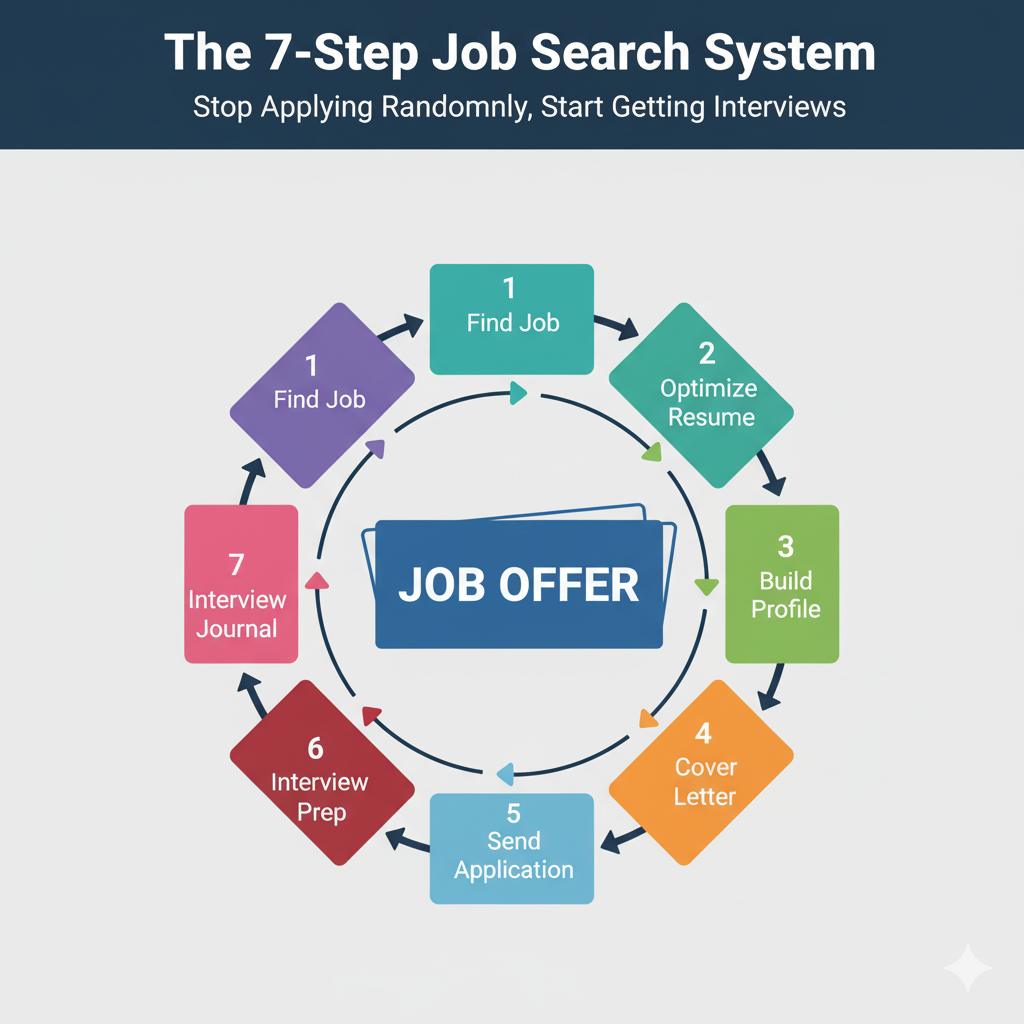
Job application tracking dashboard showing organized job search with status and follow-up dates
How to Track Job Applications Like a Pro
Let me guess what your "system" looks like:
You see a job on LinkedIn. You apply. Maybe you remember to save it. Maybe you don't.
A week later, you can't remember: Did I apply to that company? When was that? What did I even send them? Should I follow up?
You have 15 browser tabs open with different job postings. Some emails from companies you don't remember applying to. A Google Doc somewhere with... something written down?
Sound familiar?
Here's the problem: Disorganized job search = missed opportunities.
When you don't track applications systematically, you:
- Miss follow-up opportunities (companies actually want to hear from interested candidates)
- Can't learn from patterns (which approaches work, which don't)
- Waste time re-applying to the same companies
- Look unprepared when companies call (wait, which job was this?)
- Feel overwhelmed and out of control
The solution: Treat job searching like a project that needs project management.
In this guide, you'll learn the exact tracking system used by successful job seekers - the ones who stay organized, follow up strategically, and actually land offers.
Why Tracking Matters More Than You Think
Scenario 1: The Missed Follow-Up
Sarah applies to 30 jobs in two weeks. She doesn't track anything.
Company A views her resume 3 times over a week (she doesn't know this). They're interested but waiting for her to follow up. She never does. They hire someone else who showed initiative.
What tracking would have shown: "Company A viewed your profile 3x this week - send follow-up email NOW"
Scenario 2: The Pattern She Didn't See
Marcus applies to 50 jobs over a month. He gets 2 interviews.
He doesn't know:
- 30 applications went to companies he didn't match (wrong level, wrong skills)
- 15 went to companies that never viewed his resume (ATS rejected him)
- 5 went to companies that viewed his resume 2+ times (these were interested!)
What tracking would have shown: "You're getting interviews from startups 20-50 people, NOT enterprise companies. Adjust your targeting."
Scenario 3: The Double Application
Jessica sees a job she likes. Applies. Two weeks later, sees what looks like a different job at the same company. Applies again. The recruiter notices. Now she looks disorganized and desperate.
What tracking would have prevented: "You already applied to TechCorp on March 3rd. Don't apply again."

The lesson: Tracking isn't just record-keeping. It's strategic intelligence that helps you make better decisions.
What You Actually Need to Track (Minimum Viable Tracking)
You don't need a complex CRM system. You need these core data points for every application:
Essential Fields (Must Track)
1. Date Applied Why: Determines when to follow up (1 week, 2 weeks)
2. Company Name Why: Prevents double-applications, helps identify patterns
3. Job Title Why: When they call, you remember which role this is
4. Job Description (saved somewhere) Why: Needed for interview prep if you advance
5. Application Method Why: Company site, LinkedIn, email, referral? Helps track which sources work best
6. Current Status Why: Applied → Phone Screen → Interview → Offer/Rejected Keeps you organized and motivated
7. Follow-Up Date Why: Set reminder so you actually follow up (most people forget)
Nice-to-Have Fields (Level Up Your Tracking)
8. Resume Version Sent If you're tailoring resumes (you should be), track which version you sent
9. Cover Letter (Yes/No) Did you include one? Sometimes makes a difference
10. Referral/Connection Did someone refer you? Track this for follow-up and thank-yous
11. Salary Range What they're offering. Prevents applying to underpaying roles
12. Priority Level High/Medium/Low. Which jobs do you actually want?
13. Profile View Count If using trackable links, how many times did they view your resume?
14. Last View Date When did they last look? Recent views = time to follow up
15. Interview Notes Questions they asked, your impressions, next steps
16. Rejection Reason If they tell you why, write it down. Spot patterns
The Simple Tracking System: Google Sheets Method
If you're starting from zero, here's the simplest system that actually works:
Create a Google Sheet with These Columns:
| Date | Company | Job Title | Status | Follow-Up | Method | Priority | Notes |
|---|---|---|---|---|---|---|---|
| 3/15 | TechCorp | Sr. Dev | Applied | 3/22 | High | Viewed 2x | |
| 3/16 | Acme Inc | Developer | Phone | 3/20 | Company | Med | Interview Friday |
Status Options:
- Applied
- Resume Viewed
- Phone Screen Scheduled
- Phone Screen Complete
- Interview Scheduled
- Interview Complete
- Offer Received
- Rejected
- Ghosted (no response after 4 weeks)
Pro tip: Use conditional formatting to color-code:
- Green = Interview or Offer stage
- Yellow = Phone Screen stage
- Gray = Rejected/Ghosted
- White = Applied, waiting
How to Use It
Daily (5 minutes):
- Add any new applications you submitted
- Update status for any responses you received
- Check follow-up dates - send emails for anything due
Weekly (15 minutes):
- Review which applications got responses
- Analyze patterns (which companies, which methods, which titles)
- Plan next week's applications based on what's working
Monthly (30 minutes):
- Calculate metrics (applications sent, response rate, interview rate)
- Adjust strategy based on data
- Clean up old/dead applications
The Advanced Tracking System: Purpose-Built Tools
Google Sheets works, but it's manual. If you're doing more than 20 applications, consider using a tool designed for this.
What to Look For in a Job Search Tool
Must-haves:
- Automatically saves job opportunities (paste URL, it captures details)
- Tracks status through multiple stages
- Reminds you to follow up
- Shows which jobs you've applied to (prevents double-applications)
Nice-to-haves:
- Resume tracking (which version you sent)
- Trackable links (know when employers view your resume)
- Interview prep tied to specific opportunities
- Interview journaling
- Analytics/patterns
How Hiir.me Handles Tracking
Instead of tracking applications separately from your resume and prep work, Hiir.me treats each job as a complete workflow:
For each opportunity:
- Save job (AI parses description automatically)
- Build tailored profile for this job
- Track when you applied
- Get trackable resume link (know when they view it)
- Prep for interviews specific to this job
- Log interview notes and feedback
- Everything in one place
Why this matters: When a company calls about an interview, you click into that opportunity and immediately see:
- The job description
- What profile you sent them
- What you wrote in your cover letter
- When they last viewed your profile
- What interview questions you prepared
No searching through emails or browser tabs.
The Follow-Up Strategy (When to Reach Out)
Tracking is only useful if you act on it. Here's when and how to follow up:
Timeline for Follow-Ups
1 Week After Applying: Send brief email to hiring manager expressing continued interest
Sample:
Follow-Up Email Template:
Subject: Following up – [Job Title] Application
Hi [Hiring Manager Name],
I applied for the [Job Title] position last week and wanted to reiterate my strong interest. My experience with [specific relevant skill] aligns well with [specific requirement from job description].
Would you be open to a brief call this week to discuss how I can contribute to [specific company goal]?
Best,
[Your Name]
[Phone]
[LinkedIn]
2 Weeks After Applying: If no response, check status through any contacts you have
After Resume View (If Using Trackable Links): If your tracking shows they viewed your resume, follow up within 24 hours:
Thank-You Email After Application Review:
Subject: Thank you for reviewing my application
Hi [Hiring Manager Name],
I noticed you recently reviewed my application for the [Job Title] role — thank you for taking the time.
I'd love to discuss how my experience [specific relevant accomplishment] can help [company] achieve [specific goal from job description or recent news].
I'm available this week if you'd like to schedule a brief call.
Best,
[Your Name]
Why this works: It's not creepy - it's showing initiative. Plus, they KNOW you're tracking engagement, which shows you're organized and tech-savvy.
After Phone Screen: Send thank-you email within 24 hours
After Interview: Send thank-you within 24 hours, reference specific conversation points
How Often to Follow Up
Rule of thumb:
- First follow-up: 1 week
- Second follow-up: 2 weeks
- Third follow-up: Don't. Move on.
Exception: If they told you a timeline ("we'll get back to you in 2 weeks"), wait until that timeline passes plus 2-3 days.

How to Analyze Your Data (Find What's Working)
After 20-30 applications, you have enough data to spot patterns.
Key Metrics to Calculate
Response Rate:
Response Rate Formula:
(Phone Screens + Interviews) ÷ Total Applications × 100
Example:
5 responses ÷ 25 applications = 20% response rate
Goal: 15-25% response rate means you're targeting well and customizing effectively
If below 10%: You're not customizing enough or targeting wrong roles
Interview Conversion:
Interview Rate Formula:
Interviews ÷ Phone Screens × 100
Example:
3 interviews ÷ 5 phone screens = 60% interview rate
Goal: 50%+ means you're doing well in phone screens
If below 30%: You need to improve phone screen performance
Offer Conversion:
Offer Rate Formula:
Offers ÷ Final Interviews × 100
Example:
1 offer ÷ 3 final interviews = 33% offer rate
Goal: 25-40% is solid (you're not going to convert every final interview)

Pattern Analysis Questions
Look at your tracking data and ask:
Which companies responded most?
- Startup vs. Enterprise?
- Tech stack or industry?
- Company size (10-50, 50-200, 200+)?
Which application methods worked best?
- Company career page: X% response
- LinkedIn Easy Apply: Y% response
- Direct email to hiring manager: Z% response
- Referral: Usually highest response
Which job titles got responses?
- Are you targeting the right level? (If Senior roles ignore you but Mid roles respond, you're a mid-level candidate)
- Are you better at certain types of roles?
How long until responses?
- Most responses within 1 week? You're in the running
- Most responses after 2-3 weeks? You're a backup candidate
- No responses after 4 weeks? Consider those dead
Did tracked resume views correlate with responses?
- Companies that viewed 2+ times = 60% response rate
- Companies that viewed 0-1 times = 10% response rate
- Lesson: Resume views are strong signal of interest
Common Tracking Mistakes (And How to Avoid Them)
Mistake #1: Not Tracking Until You've Already Applied to 20 Jobs
Fix: Start NOW. Backfill what you remember, move forward with system
Mistake #2: Tracking Too Much Detail
Fix: Start with essentials (date, company, title, status). Add complexity later if needed
Mistake #3: Not Updating Status in Real-Time
Fix: When email arrives, update sheet immediately. Don't let it pile up
Mistake #4: Tracking But Not Following Up
Fix: Set calendar reminders. Tracking without action is useless
Mistake #5: Not Saving Job Descriptions
Fix: Companies remove job postings after hiring. Save a copy for interview prep
Mistake #6: Forgetting to Track Which Resume You Sent
Fix: If you're customizing (you should be), note which version. "Wait, what did I tell them I did at TechCorp?"
Mistake #7: Not Tracking Rejections
Fix: Write down rejection reasons when given. Patterns emerge: "Always rejected at phone screen stage" = your phone presence needs work
How to Stay Motivated When Tracking Reminds You of Rejections
Real talk: Looking at a spreadsheet with 30 rows and 25 rejections is depressing.
Here's how to reframe it:
Focus on the Funnel, Not the Rejections
Traditional view: "I applied to 30 jobs and got rejected by 25. I suck."
Data-driven view: "I applied to 30 jobs. 25 weren't a fit (that's normal - 75% rejection rate is average). But 5 responded, which is a 17% response rate. That's above average. Of those 5, I got 2 interviews. That's 40% conversion. My interview skills are strong. I just need more applications to get more at-bats."
See the difference?
Tracking shows you that rejection is part of the process, not a personal failure.
Celebrate Small Wins
Your tracking sheet should make these visible:
- First application sent ✓
- First phone screen ✓
- First interview ✓
- First time a company viewed your resume 3+ times ✓
- First offer (even if you turn it down) ✓
Each milestone is progress. Track them.
Use Tracking to Learn, Not to Judge
Bad use of data: "I'm not good enough because I got rejected"
Good use of data: "I got rejected at the phone screen stage 5 times. That tells me I need to practice phone screens. What can I improve?"
Tracking gives you actionable intelligence.
The Weekly Review: Turning Data Into Strategy
Every Sunday (or whatever your planning day is), spend 15 minutes reviewing your tracking data.
The 15-Minute Weekly Review
Minutes 1-5: Update Everything
- Add any new applications from the week
- Update statuses for all responses
- Mark dead leads as "Ghosted" (4+ weeks no response)
Minutes 6-10: Analyze Patterns
- Which applications got responses?
- Which got ignored?
- What's working? What's not?
Minutes 11-15: Plan Next Week Based on your data:
- Adjust targeting (more of what's working)
- Set follow-up reminders
- Schedule applications (how many, which companies)
Output: A clear action plan for the coming week
How Tracking Changes Your Job Search Mindset
Before tracking, job searching feels like:
- Throwing resumes into a black hole
- Hoping something happens
- Feeling powerless and frustrated
After tracking, job searching feels like:
- Running experiments and measuring results
- Adjusting strategy based on data
- Having control over the process
Same activities. Different mindset.
The data doesn't lie. If you're getting 5% response rate, the data shows you need to change something (targeting? customization? resume format?).
If you're getting 25% response rate but 0% interview conversion, the data shows your phone screen skills need work.
Tracking turns job searching from hope to strategy.
The System That Makes Tracking Automatic
Here's the problem with all tracking systems: They require discipline.
You have to remember to:
- Add each application manually
- Update statuses
- Set follow-up reminders
- Save job descriptions
- Track which resume you sent
Most people start strong, then it falls apart.
The solution? Use tools that automate as much as possible.
What Auto-Tracking Looks Like
Instead of: "Let me copy-paste this job description into my spreadsheet..."
Auto-tracking: Paste job URL → System scrapes and saves everything automatically
Instead of: "Did I remember to set a follow-up reminder?"
Auto-tracking: System automatically sets follow-up dates based on when you applied
Instead of: "Let me check if they viewed my resume..."
Auto-tracking: Get notification: "Company X viewed your profile 2x this week - time to follow up!"
Instead of: "Which resume did I send them again?"
Auto-tracking: Click opportunity → see exactly which profile you sent, when, and if they viewed it
How Hiir.me Automates Tracking
Every job you save becomes a tracked opportunity:
- ✓ Job details automatically parsed
- ✓ Status tracked through all 7 steps
- ✓ Trackable resume link generated (know when they view it)
- ✓ Follow-up reminders set
- ✓ Interview prep linked to this specific job
- ✓ Interview notes saved with this opportunity
Result: You don't have to remember to track. The system tracks for you.
Price: Try 3 complete workflows free. Then $5/month unlimited.
Compare to building your own system:
- Google Sheets: Free but 100% manual
- Notion templates: $0-10/month, still mostly manual
- Career coaching: $100-500/hour to tell you to track (you still have to do it manually)
Real Examples: How Tracking Led to Job Offers
Example 1: The Pattern Marcus Spotted
Marcus tracked 40 applications over 6 weeks:
- Enterprise companies (500+ employees): 2% response rate
- Mid-size companies (50-200 employees): 25% response rate
What he changed: Stopped applying to enterprise, focused on mid-size companies
Result: Next 10 applications got 4 responses, 2 interviews, 1 offer
Tracking revealed: He was better suited for mid-size company culture, not enterprise bureaucracy
Example 2: The Follow-Up Sarah Almost Missed
Sarah's tracking showed:
- Applied to Company A on Monday
- They viewed her resume Tuesday
- Viewed again Thursday
- Viewed again Friday
Without tracking: She would have waited 2 weeks to follow up (standard advice)
With tracking: She followed up Friday afternoon: "I noticed you reviewed my application several times this week. I'd love to discuss the role."
Result: Phone screen scheduled for Monday, job offer 2 weeks later
Hiring manager later told her: "We were impressed you noticed we'd viewed your profile multiple times. It showed initiative and technical awareness."
Example 3: The Resume Format Jessica Fixed
Jessica tracked 25 applications:
- 0 responses
- Her tracking showed: Only 2 companies had even viewed her resume
Diagnosis: ATS was rejecting her fancy-formatted resume
What she changed: Switched to plain-text, ATS-friendly format
Result: Next 15 applications got 5 responses
Tracking revealed: Her content was fine. Her format was the problem.
The Bottom Line: Track or Stay Frustrated
You have two options:
Option A: Don't Track
- Apply to jobs randomly
- Forget what you applied to
- Miss follow-up opportunities
- Can't learn from patterns
- Feel out of control
- Stay frustrated
Option B: Track Systematically
- Know exactly where every application stands
- Follow up strategically when companies show interest
- Spot patterns in what's working
- Adjust approach based on data
- Feel in control
- Actually land offers
Same amount of work applying. Different results.
The only difference? 15 minutes per week tracking and analyzing.
Start Tracking Today (Even If You've Already Applied to 50 Jobs)
Step 1: Choose your system
- Simple: Google Sheets
- Advanced: Purpose-built tool like Hiir.me
Step 2: Backfill what you remember
- List every company you've applied to (from memory, email confirmations)
- Add whatever details you remember
- Mark status as best you know
Step 3: Start tracking forward
- From today forward, track EVERYTHING
- Add new applications immediately
- Update statuses in real-time
- Set follow-up reminders
Step 4: Review weekly
- Every Sunday, 15 minutes
- Analyze patterns
- Adjust strategy
- Plan next week
Ready to Get Organized?
The complete job search tracking system:
✓ Automatically save opportunities (paste URL, AI captures details) ✓ Track status through all 7 workflow steps ✓ Get trackable resume links (know when they view) ✓ Set automatic follow-up reminders ✓ Link interview prep to specific opportunities ✓ Journal interviews with feedback
Try 3 complete workflows free. Then $5/month unlimited.
Stop losing track of opportunities. Start following a system.
[Start Tracking Your Applications →]
Frequently Asked Questions
Q: Is tracking really necessary for entry-level jobs? A: Yes, especially for entry-level. You're competing against hundreds of other grads. Organization and strategic follow-up separate you from everyone else.
Q: What if I've already applied to 100 jobs without tracking? A: Start now. Backfill what you remember, track everything moving forward. Even partial data is better than no data.
Q: How do I track applications I submitted months ago? A: Mark them as "Ghosted" (no response after 4 weeks). Don't count them in your current metrics. Focus on tracking new applications.
Q: Should I track applications to jobs I don't really want? A: If you applied, track it. Use "Priority" field (Low/Med/High). But honestly, don't apply to jobs you don't want - it's wasting everyone's time.
Q: What's the best tool for tracking? A: Start with whatever you'll actually use. Google Sheets if you like manual control. Hiir.me if you want automation. The best tool is the one you'll stick with.
Q: How long should I keep tracking old applications? A: Archive anything older than 3 months with no response. Keep your active tracking sheet to current/recent applications only.
Related Articles
- [The Complete 7-Step Job Search System] - The full workflow this tracking system supports
- [What is an ATS? Why 75% of Resumes Get Rejected] - Understand why tracking matters for ATS optimization
- [How to Follow Up on Job Applications (Without Being Annoying)] - Deep dive into follow-up strategy
Stop losing track. Start landing offers.
[Get Your Free Job Application Tracker →]
